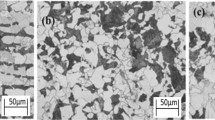Abstract
The hot-core heavy reduction rolling (HHR2) process makes use of the reverse temperature gradient of casting steel to eliminate the inner shrinkage and porosity defects during continuous casting. As the key connecting process between continuous casting and rolling, the charging process affects the microstructure evolution of workpiece rolled by HHR2 process. The direct rolling and hot-charging experiments were carried out for the workpieces rolled by HHR2 process, to investigate the effects of charging process on the microstructure and mechanical properties of hot-rolled steel plate. For comparison, the conventional cold-charging experiments were also performed on the workpiece without HHR2. The results show that the similar microstructures and mechanical properties can be obtained from the hot-rolled plates produced from the workpieces rolled by HHR2, which were followed by direct rolling or hot-charging process, as well as that of hot-rolled plate produced from the workpiece without HHR2 via cold-charging process. Moreover, the microstructure and mechanical properties at the core of the hot-rolled plate via direct rolling process are better than those without HHR2. It indicates that the γ-α-γ reciprocating phase transformation, which occurs during the cold-charging process, can be replaced by deformation recrystallization that occurs during the HHR2 process, to refine austenite grains.











Similar content being viewed by others
References
M. Kawamoto, Recent Development of Steelmaking Process in Sumitomo Metals, J. Iron Steel Res. Int., 2011, 18, p 28–35.
C.H. Yim, Y.M. Won, J.K. Park, S.H. Kwon, Continuous Cast Slab and Method for Manufacturing the Same, US Patent No. US8245760B2, (2012).
M. Kawaberi, Y. Yamamoto and K. Asoh, Improvement of Properties of Rods and Bars by Continuous Forging Process, Kawasaki Steel Tech. Rep., 1994, 26(1), p 26–32. ((in Japanese))
S. Nabeshima, H. Nakato, T. Fujii, T. Fujimura, K. Kushida and H. Mizota, Control of Centerline Segregation in Continuously Cast Blooms by Continuous Forging Process, ISIJ Int., 1995, 35(6), p 673–679.
C. Ji, C. Hui Wu and M. Yong Zhu, Thermo-Mechanical Behavior of the Continuous Casting Bloom in the Heavy Reduction Process, JOM, 2016, 68(12), p 3107–3115.
W. Rindler, E. Kozeschnik and B. Buchmayr, Computer Simulation of the Brittle-Temperature- Range (BTR) for Hot Cracking in Steels, Steel Res., 2000, 71(11), p 460–465.
X. Zhao, J. Zhang, S. Lei and Y. Wang, Finite-Element Analysis of Porosity Closure by Heavy Reduction Process Combined with Ultra-Heavy Plates Rolling, Steel Res. Int., 2014, 85(11), p 1533–1543.
M. Gong, H. Li, T. Li, B. Wang and Z. Wang, Evolution of Austenite Grain Size in Continuously Cast Slab during Hot-Core Heavy Reduction Rolling Process Based on Hot Compression Tests, Steel Res. Int., 2018, 89(7), p 1800025.
T. Li, H. Li, R. Li, Z. Wang and G. Wang, Work Roll Surface Profile Design and Optimization for Hot-Core Heavy Reduction Rolling Process, ISIJ Int., 2019, 59(7), p 1314–1322.
T. Li, H. Li, R. Li, Z. Wang and G. Wang, Analysis of Ductile Fractures at the Surface of Continuous Casting Steel During Hot-Core Heavy Reduction Rolling, J. Mater. Process. Technol., 2020, 283, p 116713.
H. Jun Li, T. **ang Li, R. Hao Li, M. Na Gong, Z. Dong Wang and G. Dong Wang, Effect of a Novel Hot-core Heavy Reduction Rolling Process after Complete Solidification on Deformation and Microstructure of Casting Steel, ISIJ Int., 2019, 59(12), p 2283–2293.
H. Li, M. Gong, T. Li, Z. Wang and G. Wang, Effects of Hot-Core Heavy Reduction Rolling During Continuous Casting on Microstructures and Mechanical Properties of Hot-Rolled Plates, J. Mater. Process. Technol., 2020, 283, p 116708.
V.V. Sagaradze, An Ultrafine Grain Structure Formed as a Result of Cyclic γ→α→γ Transformations, Nanostruct. Mater., 1997, 9(1), p 201–204.
V.V. Sagaradze, V.E. Danilchenko, P. L’Heritier and V.A. Shabashov, The Structure and Properties of Fe-Ni Alloys with a Nanocrystalline Austenite Formed Under Different Conditions of γ-α-γ Transformations, Mater. Sci. Eng. A., 2002, 337(1), p 146–159.
W. Roberts, A. Sandberg, T. Siwecki, T. Werlefors, ASM, Met. Park, (USA, OH) 1984, p. 67.
C. Zener and J.H. Hollomon, Effect of Strain Rate Upon Plastic Flow of Steel, J. Appl. Phys., 1944, 15, p 22–32.
M. Gong, H. Li, B. Wang, Z. Wang and R.D.K. Misra, Interaction of Strain Refined Precipitates and Recrystallized Grains in Nb-Ti Microalloyed Steel during Continuous Casting, Hot-Core Heavy Reduction Rolling, and Reheating Process, J. Mater. Eng. Perform., 2019, 28(6), p 3539–3550.
T. Hüper, S. Endo, N. Ishikawa and K. Osawa, Effect of Volume Fraction of Constituent Phases on the Stress-Strain Relationship of Dual Phase Steels, ISIJ Int., 1999, 39(3), p 288–294.
N. Wen**, C.H. Chenjia, G. Hailong, Z.H. **aobing and C.H. Shaohui, Control of Microstructure of Ferrite/Bainite (F/B) Dual-Phase Steels and Analysis of their Resistance to Deformation Behavior, Acta Metall Sin., 2012, 48(3), p 298–306.
X. Shi, P. Yin, W. Yan, Y. Shan and Y. Ren, Effect of Bainite Content on Mechanical Properties of Ferrite/Bainite (F/B) Dual Phase Pipeline Steel, **shu Rechuli, 2021, 46(1), p 187–192.
Acknowledgments
The authors are very grateful for the financial support of the National Key Research and Development Program of China (No. 2017YFB0305300).
Author information
Authors and Affiliations
Corresponding author
Additional information
Publisher's Note
Springer Nature remains neutral with regard to jurisdictional claims in published maps and institutional affiliations.
Rights and permissions
About this article
Cite this article
Li, H., Li, T., Gong, M. et al. Effect of Charging Process on Properties of Steel Plates Formed via Hot-Core Heavy Reduction Rolling. J. of Materi Eng and Perform 31, 318–327 (2022). https://doi.org/10.1007/s11665-021-06208-y
Received:
Revised:
Accepted:
Published:
Issue Date:
DOI: https://doi.org/10.1007/s11665-021-06208-y




